
The rapid global acceleration of the renewables revolution is, in this writer’s opinion, perhaps the single most civilizationally important development of the 2020s to date (right up there with mRNA vaccines). Though displaced from the headlines by politics, war, and cultural drama, the world is increasingly powered by clean energy. A recent report from pioneering think tank Ember found that 2023 saw renewables provide a record-high 30% of human civilization’s electricity, potentially marking the peak of emissions from the global electricity sector1. And that statistic actually undersells renewables’ progress substantially: while fossil fuels are still a majority of the “stocks” of existing capacity in many (not all!) countries, the “flows” tell a different story: around the world, from America to Europe to China to India, almost all the new electricity-generating capacity being built is renewable. All this growth is mostly driven by solar, which has been the fastest-growing source of electricity generation for nineteen years in a row. In 2023 globally, solar generation expanded by 23%, while fossil fuel generation expanded by less than 1%.
Furthermore, thanks to ever-improving grid-scale battery technology (plus other trusty energy storage standards like pumped hydro), it’s increasingly clear that there’s no upper limit to how much of a modern economy can be powered by clean electrons. In April 2024, fossil fuels generated less than one-quarter of the European Union’s electricity (the first such month in history!), with renewables plus nuclear providing over 75%. In that same month, the entire state of California ran on 100% renewable electricity for nine straight hours, the longest amid dozens of other days similar with 100% renewable “streaks.”
As readers of The Weekly Anthropocene have probably by noticed by now, I’ve been fascinated with the current expressions and future potential of renewable energy for years. And the speed and magnitude of the renewables rollout in rapidly developing India, where 1.4 billion people demand and deserve abundant electricity like Americans and Europeans enjoy, will be an absolutely vital factor in determining the future stability of Earth’s climate. Thus, after writing and chilling out a bit for a day and a half in Bengaluru2, I decided to go see the Pavagada Ultra Mega Solar Park, near the border between the states Karnataka and Andhra Pradesh. This was one of the jewels of India’s massive ongoing solar buildout, and I wanted to experience firsthand what it was like to live amidst this clean energy landscape.
As of 2021, the Pavagada Solar Park was the third largest solar farm on the planet3. With a capacity of over two thousand megawatts (2.05 GW) from panels occupying over 13,000 acres of arid land, it’s much bigger than any American solar farm built to date. I’d first heard about Pavagada from a New Yorker article, and noticed that it was only a little ways north of Bengaluru. Doing reconnaissance on Google Maps, I saw that the village of Thirumani was nearly surrounded by the Pavagada solar farm. Perfect; these folks would definitely have thoughts on the project.
I had no appointment or contacts associated with this project, as it had been a last-minute itinerary addition, and it wasn’t exactly an open-to-the-public tourism side. Besides, even if I had decided to go here earlier, I didn’t fancy my chances of getting a formal journalism permit4 to see a major national energy infrastructure site based on the dubious prestige of an independent Substack.
That left my classic option of last resort: wing it. I would go to the village of Thirumani in the heart of the Pavagada Solar Park and commence my patented “Show Up, Wander Around, See If Anyone’s Willing to Talk to You” style of on-the-ground reporting. After all, it worked in the Netherlands.
Hoping to experience a more representative Indian transport experience, I bought an “ordinary” second-class ticket from Bengaluru to Penakonda (the nearest train station to Thirumani) and was soon standing in a crowded semi-open space at the junction of two carriages, with rows of double-decker seats stretching out before me and a medley of standees, families, and people toting large packages from backpacks to rice sacks around me. A semi-regular flow of passing water, tea, and snack sellers necessitated near-constant movement as individual-level adjustments rippled out and back amid the tightly packed crowd. One of the men squatting near me asked to take a selfie because I was the first American he’d ever seen in person.
Upon arrival the Penukonda train station, I did a brief double-take when I realized that a group of bonnet macaques, the same species I’d scrutinized alongside WCS researchers in Sanjay Gandhi National Park, were just hanging out around the entrance/exit gate and the metal railway superstructure. I could clearly see that one was a very pregnant female; the population seemed to be doing well despite (or perhaps because of) the aridity and the built-up conditions. The monkeys of India keep surprising me like this; despite knowing otherwise, I mentally default to an expectation that wild primates will be a rare and elusive sight, but these guys are as fearless and human-habituated as the raccoons or eastern gray squirrels of Maine.
I walked a very little ways into town, admired the great mesa dominating the skyline, and hired an auto-rickshaw. The driver seemed pretty confused when I pointed out where I wanted to go on Google Maps (“see, Thirumani, it’s a village in the middle of giant solar farm near here!”), but we soon had a deal.
Among the first things I saw as we drove out of Penukonda was a majestic wind farm, orange-striped turbines spinning in the breeze amid an intricate steel spiderweb of electron-channeling transmission lines. I hadn’t even known that there was a wind farm here, but it was certainly a pleasant surprise! The wind sector is almost becoming overshadowed by the exponential economy-transforming growth of solar, but wind is still progressing too. Wind turbines globally are getting physically bigger and bigger, with one startup proposing to build the world’s largest-ever plane just to more effectively transport extra-extra-large turbine blades. Artificial reef-catalyzing offshore wind is also , with the Biden Administration leading the USA to finally join China and Europe as a player in this sector. The Vineyard Wind and South Fork Wind farms in the American Atlantic have already been connected to the grid, many more are approved and will start building soon, and early planning is underway for wind farms in the Gulf of Maine.
As we continued, the motor-rickshaw was eventually brought to a halt by a man herding his goats across the road in front of us. This rapidly developed into a full-on traffic jam, with a car and a motorcycle caught in the goat vortex as the beleaguered herder endeavored to keep the flock together.
Geophysically, the landscape I saw on the approach to Thirumani reminded me of the red-soiled and mesa-studded Betsileo country of south-central Madagascar, or perhaps the arid Nevadan side of the Sierras. Culturally, it appeared to me as a fascinating melange of past, present, and future. Some aspects of this landscape had likely been the same for hundreds of years. Cattle were lazing in the shade, sometimes in pairs or small groups around households or the edge of small farmers’ fields, while chickens pecked around doorways and avoided exploring puppies. We passed a little roadside temple decked out in vivid Technicolor pigments where I thought I recognized the figure of Krishna. But tractors and motorcycles shared the (paved) roads with goatherds and bullocks. Plastic trash piled up in windblown corners and along the sides of buildings. Wind turbines spun on hills in the middle distance, and one of the world’s largest solar farms was just ahead.
Once we reached the village center of Thirumani, my sensation of having entered a cross-temporal mosaic grew stronger. In the Arthur C. Clarke/Stephen Baxter sci-fi novel Time’s Eye, alien intervention creates a world that’s a patchwork of different periods of Earth history, with australopithecine-like hominids, Alexander the Great, and Victorian British troops all transported and eventually intermingling. Downtown Thirumani felt a bit like that to me. Bullock carts of an ancient Indian design were passing through the city center, some with patriotic green and saffron ribbons tied to their horns…but even these traditional carts had modern pneumatic tires. Transmission lines arced overhead, feeding power to businesses and homes. A school, a government-sponsored Canara Bank outlet, and a hospital brought to mind the concrete benefits of education, healthcare, and financial access. At a roadside bakery, people asked me for selfies with their pocket supercomputer-smartphones, and I noticed that like much of India this small business used the pioneering open-source and cost-free UPI payment system, which is rapidly spreading through the developing world but still mostly unknown in the West5. The proprietor offered me a small pastry-like thing that was completely unfamiliar to me: I could only describe it as a sort of candied tomato. Most people didn’t speak English, and some seemingly intimated that I was the first foreigner they had seen in person, but I had cellular data coverage here and was able to use Google Translate to generate sentences briefly explaining who I was and why I was here in Kannada. A few village children asked me earnestly, “Are you a YouTuber?”
It was around this time that I happened to fall in with a group of three local guys, Hemant, Harsha, and Akhil, all on the cusp between teenage boys and twenty-something men, who spoke more English than the folks I had met earlier. Curious, they approached me and offered to show me different bits of the solar farm in the immediate area. They reminded me of figures from mid-century American literature, with a hard to define un-cynical “group of pals” attitude that came across as faintly retro to an American Gen Zer like me. Two were university students studying computer science-related fields in Bengaluru, and the third had started a bakery right here in Thirumani. Some of our conversation topics felt very Indian: one of them had a motorcycle emblazoned with the figure of Hanuman and his mace, and enthusiastically talked to me about cricket star Virat Kohli of the Royal Challengers Bengaluru team. Later on, Akhil and I would discuss India’s Chandrayaan-3 moon rover mission, the Himalayan border disputes with China, and how the USA was too restrictive on granting visas to Indian nationals (I heartily agreed). Others could have taken place anywhere in the world: they asked if I’d brought a drone, and showed me their group Instagram account.
Touring the great solar park, I thought of the economic and ecological logistics behind it. As of 2017, when the solar farm construction had begun, the Karnataka state government had declared the Pavagada region drought-stricken 54 times in the last 60 years. The Pavagada landscape was on its last legs as a food producer, but has become a world-leading superstar as an energy producer. Across India, aridifying farming regions are being pulled back from the brink of socioeconomic disaster by the arrival of new solar projects. I hoped that this model could successfully be replicated in other parts of the world where small-scale agriculture was succumbing to climate shifts: Mexico, Iraq, and Kenya came to mind, but sadly the Sahel region would probably remain too unstable for large-scale solar for a while yet.
The three guys escorting me told me that they’d seen a robot system being trialled to clean dust off the panels at night, but that manual approaches were still predominant in the pre-dawn cleaning period. I envisioned what a fully automated solar park of the future could look like, with rapidly-increasing battery technology enabling robots to patrol and polish vast fields of panels before needing to recharge. That got me thinking about battery technology in general, the next step on the renewables revolution pathway, which didn’t seem to have really reached Pavagada yet. India is only just now building its first stand-alone grid-scale battery storage project, at the Kilokari substation near Delhi. Lots of newly built renewables projects in the USA and EU now come with really big batteries to store up excess power for windless nights, but to the best of my knowledge the Pavagada Ultra Mega Solar Park doesn’t have any associated grid-scale batteries. It’s just a Platonic ideal of Building Lots of Freakin’ Solar Panels, feeding clean sun-power to India’s hungry grid during the day. It’s a fool’s errand to try to trace an individual electron, but my Airbnb in Bangalore was very possibly lit and cooled in part by Pavagada power.
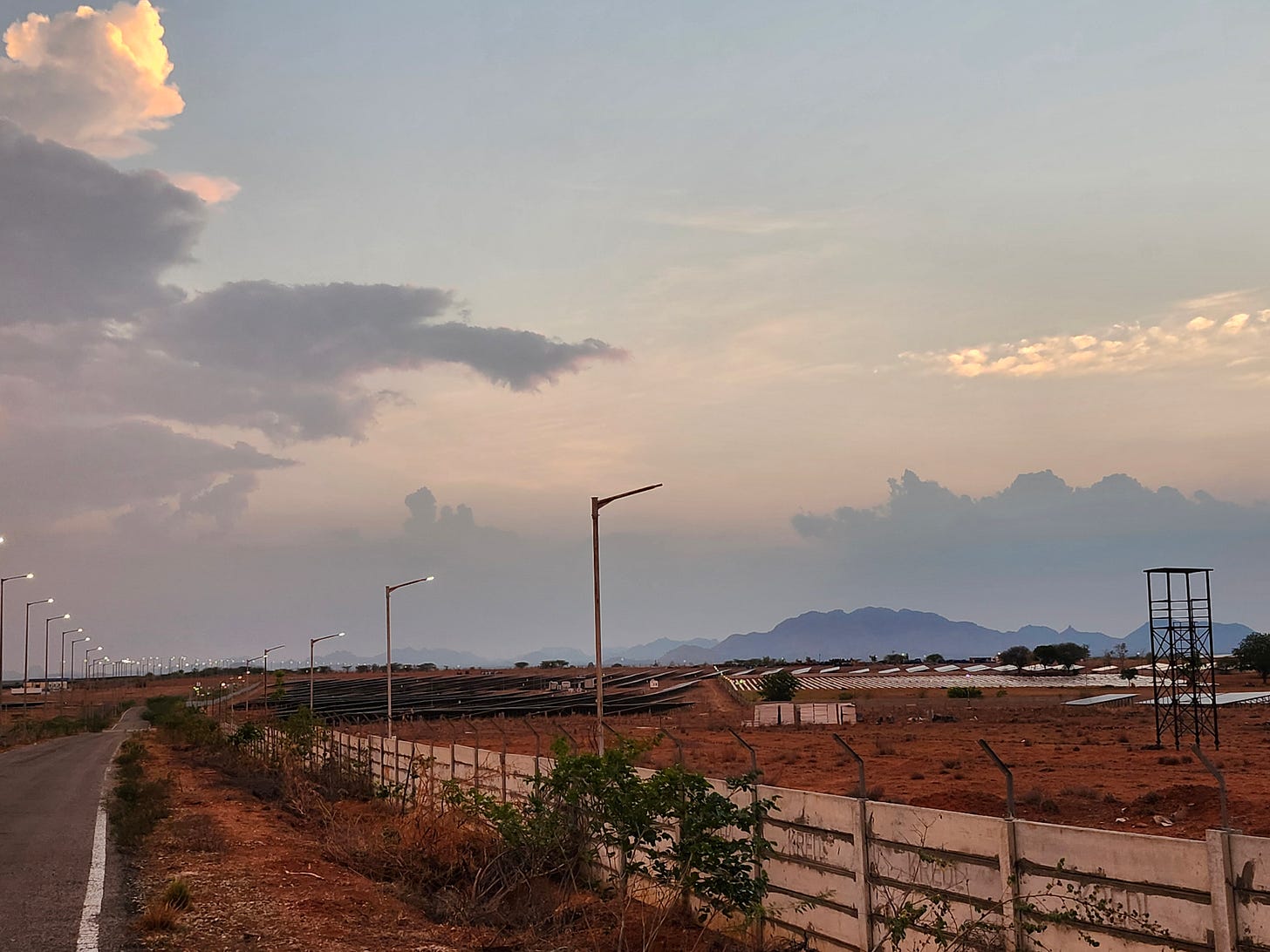
As we continued along the network of roads, I was impressed as always by the sheer magnificent simplicity of solar panels as a way of generating power. There were no particulate matter-belching smokestacks here, no watershed-poisoning liquid discharges, not even any moving parts: just photons knocking electrons off silicon. As Bill McKibben and others have so poetically invoked, we’re finally starting to make direct use of the energy flow from the giant nuclear fusion reactor conveniently sited one astronomical unit away.
Night was falling by the time we reached a humming substation at the juncture of one of the many roads crisscrossing the great solar park. Around this time, Akhil invited me to stay the night at his family’s place, and I accepted his spontaneous kindness with gratitude.
Their home had a beautiful painting of a winged apsara on the wall, reminding me of the carvings I’d seen at Kanheri Caves. Akhil’s kind and welcoming mother Suvarna invited me in for dinner, and I learned in the subsequent conversation that I had fallen in with a family that rather exemplified the ripple effects that can arrive thanks to a well-managed renewable energy transition.
Sudhakar, Akhil’s dad, had been a farmer, as his family had been for generations, but like many in the area he was finding it harder and harder to make it work. “Before solar, there was no rain, and the crops failed.” When the solar park came, it had provided an immense cash influx to local small-scale landowners. The park spread across 13,000 acres, and for many of those acres it was leasing the land from local farmers6. Akhil and Suvarna both told me that the rate the government paid them was 25,000 rupees per acre per year, rising by 1,000 rupees every year. Their family had leased 23 acres to the Pavagada solar farm, keeping just a fringe of 6 acres around their house to grow pomegranates, sweet corn, and chillies. Sudhakar now worked as Head of Security for one section of the solar park. (He was asleep on the terrace when I arrived, so I never got to talk to him in person, but I talked a lot with Akhil and Suvarna).
A bunch of stories like these had brought a new prosperity to the town. Suvarna told me that people had been moving out of Thirumani en masse, but many had returned since the Pavagada solar park was built and were now working in the village at salaries higher than what they had earned as laborers in Bengaluru. Suvarana applauded the consistent 24 hours of electricity her family now enjoyed, an end to rolling blackouts. People were sending their kids to higher education: a kid born to a family here might now have a chance at working as an AI developer in their future career. And the benefits seemed broad-based, too: Akhil and his friends before had joked that the guy who’d stayed in the village to run a bakery was “making lakhs” with a thriving business.
Enjoying their kind hospitality, I began to realize that subtle aspects of the home and family dynamic felt very familiar to me. We were sitting on the floor for a traditional-style dinner of deliciously spicy dal and rice, but there was a couch in the same room and Indian Premier League cricket on the TV. Akhil told me he was studying artificial intelligence and machine learning, and would return to his university classes in Bengaluru tomorrow. The general vibe could’ve been from any of the New England family houses I’d visited as a teenager. It felt American. No, not American, modern, expressing the same general socio-technological gestalt lifestyle that first became widespread in America in the twentieth century, but is now emerging across much of the rest of the world.
I was strongly reminded of a passage from an article I’d read by Substack economics commentator Noah Smith on the ongoing industrialization of South and Southeast Asia. (Some context: “Altasia” is a novel economics/geopolitics term referring to essentially all of East and South Asia minus China, North Korea, and Myanmar. “Altasia” as a whole is a rapidly economically developing region, and all its countries combined already have a larger working-age labor force than China and export more goods by value to the United States than China).
“We haven’t seen an entire region industrialize all at once since Europe in the late 1800s (the closest thing being the Asian “tiger economies” of the 80s and 90s, which was really just Altasia’s predecessor). This will be much bigger. Investment and trade and diplomatic links will be flying back and forth between these various countries at a frenetic pace. Everyone will be trying to figure out who builds what where, where they source from, and where they sell to. Eventually, cultural links will follow.
And for Western companies looking for new markets, Altasia will potentially be more exciting than China ever was. The Chinese market delivered riches to some, but the government banned some products (especially internet services) and stole the technology used to make others. Ultimately, China’s billion consumers turned out to be a mirage for many. The economies and societies of Altasia, in comparison, are much more open to foreign products.
And in the poorer countries of Altasia — India, Indonesia, Vietnam, Bangladesh, Philippines, etc. — there will be the heady excitement of industrial development. It will be their turn to build highways, their subways, their gleaming forests of apartments and office towers. It will be their turn to buy cars and big-screen TVs, go out to eat, go dancing at clubs, and send their kids to college. Developing Altasia will be a damn exciting place to be in next three decades.”
-Economist Noah Smith on Substack.

That’s very much the sense I got in Thirumani: it’s their turn to rapidly acquire the benefits of technological modernity. The whole developed-world package of electricity, motor vehicles, TV, Internet access, clean water infrastructure, tertiary education, and digital knowledge work is very much present in much of the rural India of today, and the human potential unleashed by this access will shape the future of the global economy. Even better, there’s a good start being made to power the continuation of this nascent prosperity explosion with clean, renewable energy, with solar and wind already accounting for most of the new capacity being built in the country and hopefully soon starting to displace the legacy coal plants on India’s grid. The reduction in air pollution alone could spare untold millions of future Indians painful deaths from asthma or lung cancer. In a best-case scenario, perhaps by 2100 a prosperous, healthy India can look back with pride at being the first large nation to reach developed-country status primarily due to renewable energy, not fossil fuels.
The way back was rather on the eventful side. I took a morning bus from Thirumani to Penukonda, only to find that the train scheduled to sally forth towards Bengaluru around midday had been canceled. I waited for the next train in the Penukonda station for a few hours7 as the platform filled up with fellow would-be passengers. Once we got on board, it was super-hyper-crowded, with families squatting down to form tiny luggage-shielded enclaves as people were piling up huge bags of rice on the floor behind me. At some points people were nearly hanging out of the open door on the moving train, inadvertently acting as human shields against a brief yet violent burst of unseasonal rain8.
And yet, in this seemingly steampunk transport environment, many if not most of the people I could see were on calls, playing games, and browsing the Internet on their phones.
There’s a lot of criticism of smartphones, much of it eminently deserved. It’s easy to see them as destroyers of attention spans, commodifiers of relationships, polarizers of politics, wreckers of childhoods. As a near-omnipresent habit with potential negative long-term health impacts, it’s possible that they may someday be remembered as the cigarettes of our age.
But I think that we’re missing the forest for the trees here a little bit. New information technologies are often highly disruptive: the printing press likely helped kick off the Protestant Reformation and generations of bloody religious wars in Europe, Hitler and Stalin used radio broadcasts to give speeches commanding their brutal totalitarian regimes. We’re still in the very early stages of societally “metabolizing” the wonder that is the smartphone, we haven’t developed the social/psychological customs and mores needed to appropriately manage and control its impacts yet. And while its disruptions are readily apparent and often painful, I suspect that its advantages have become so taken for granted so quickly that we’ve forgotten how amazing it truly is. The East African plains ape has built a global communications network from scratch! In Thirumani, I was able to walk into a small town on the other side of the planet from where I lived, not speaking a word of the local language, and instantly pull up a live translator on a device that fit in my pocket. I used Google Maps and the Rome2Rio travel website to plan the entire journey, identifying the best routes from Bengaluru to Thirumani with instant algorithmic precision. The rickshaw driver only spoke a few words of English and didn’t seem to know where Thirumani was, but he like me used Google Maps and I could plot my requested route on his phone. On the bus and train rides, I was able to read e-books, check email, and surf the web. And most poignantly, throughout my trip to India, I can talk to my loved ones from the other side of the world on a little rectangle of glass in my hands, seeing their faces and hearing their voices.
Multiply all this by a few billion, and we begin to see what a milestone the smartphone truly is. It’s a universal translator reversing the Tower of Babel legend, a handheld one-stop-shop console for running a business or accessing government services, a Library of Alexandria in your pocket, a portal to your loved ones’ face, an album of treasured memories. Since I’ve arrived in India, I’ve also begun to feel that it’s common ground, that basic phone utilities like digital maps and translators and photos provide a shared context for people from drastically different cultures. The smartphone is a Lens of Civilization, a new component of the Basic Human Tech Package, perhaps with the potential to be as transformative and long-lasting as fired pottery or the wheel. It’s not surprising that many parts of the world now have more smartphones than flush toilets: if I personally could only choose one, I’d probably pick the smartphone as well. Gram-for-gram, the smartphone is hard to beat as probably the most extraordinary unlocker of human creativity and ingenuity in history.
Solar parks, wind farms, power lines, smartphones, trains, advanced payment systems, bullock carts, goat herds…the complexity and diversity of the technologies on hand in rural, arid Thirumani made me feel almost dizzy thinking of the kaleidoscopic possibilities for humanity and its biosphere inthe Anthropocene. I really hope that whatever comes next is overwhelmingly powered by clean energy, and at least in the near term that means a whole lot more ultra-mega solar parks like Pavagada. I don’t remotely know how this is all going to turn out, this crazy confluence of technological progress and socioeconomic turbulence and biosphere-level transformation that we’re all living through in the 21st century. But I can tell you one thing. The Electric Age of Humanity is only just beginning.
Also keep in mind that there’s a bit of a Red Queen’s Race aspect to this: human civilization doesn’t just need to replace its existing electricity-generating capacity with renewables, we need to electrify the transport and industrial sectors as well to get rid of emissions from internal combustion engines, heating, and manufacturing. Global electricity demand is increasing, and will need to increase still further to fully decarbonize our economy with heat pumps, EVs, electric arc furnaces for steelmaking, and more.
I found Bengaluru, aka Bangalore, to be a lovely city, by the way. The within-city metro system is impressively fast, clean, spacious and well-organized. Cubbon Park was pretty, but crowded enough that I paid only a brief and flying visit. The neighborhood where I was staying, Indiranagar, definitely gave an impression of having more disposable income than most of the areas of Mumbai I’d visited, with more trees on the streets, less trash, and a little more space between buildings. I couldn’t remotely read the alphabet of Kannada, the local language, but almost everything from menus to street signs was double-labeled in Kannada and English, so it was very easy to get around. The masala dosa at Om Sai Skanda was absolutely exceptional. It may well have just been confirmation bias, but I felt like I could really see that this city was a hub of India’s offshore IT services sector. Just to take one example, a random guy next to me on the metro turned out to be working in customer support for U.S. Medicare. The globalized digital economy produces interesting results.
Depending on how you count it, Pavagada may still be the third largest; it’s tough to precisely define sizes here as solar farms are inherently modular and often spread across wide areas.
I’d already been down that road to try to get a formal journalism (and/or volunteer researcher) permit to accompany the WCS leopard team during sensitive fieldwork like radio-collaring leopards. No dice: turns out it would have been a super-bureaucratized and highly-probably-unsuccessful process.
I couldn’t even access UPI without an Indian telephone number: most Indian folks pay for stuff with one of a range of UPI apps on their phones, but I was dependent on withdrawing rupees from ATMs. There’s a really interesting geoeconomic “flipping the script” here. Coasting off decades of technological leadership, it seems surprising that as an American I don’t have at least the possibility of access to whatever the latest cutting-edge system is, but in a more multipolar world where more countries are developed enough to be at the forefront of technological innovation (and where more recently developed countries might have a lack-of-incumbents flexibility advantage to “leapfrog” entrenched existing systems), it’ll become less and less surprising.
Of course, this disproportionately benefits the folks who owned land already, but still: a massive wealth transfer to an aridifying rural area to enable clean energy development is pretty close to an unalloyed good in the Anthropocene!
The station had a really interesting mural showing a sleeping Kumbhakarna, the giant who was brother to the demon-king Ravana, villain of the Ramayana epic. I didn’t get to visit, but the town of Penukonda was also home to the Penukonda Fort, one of the last redoubts of the Vijayanagara Empire. The depth and richness of history in India continues to astonish me.
A harbinger of things to come, as it would turn out.






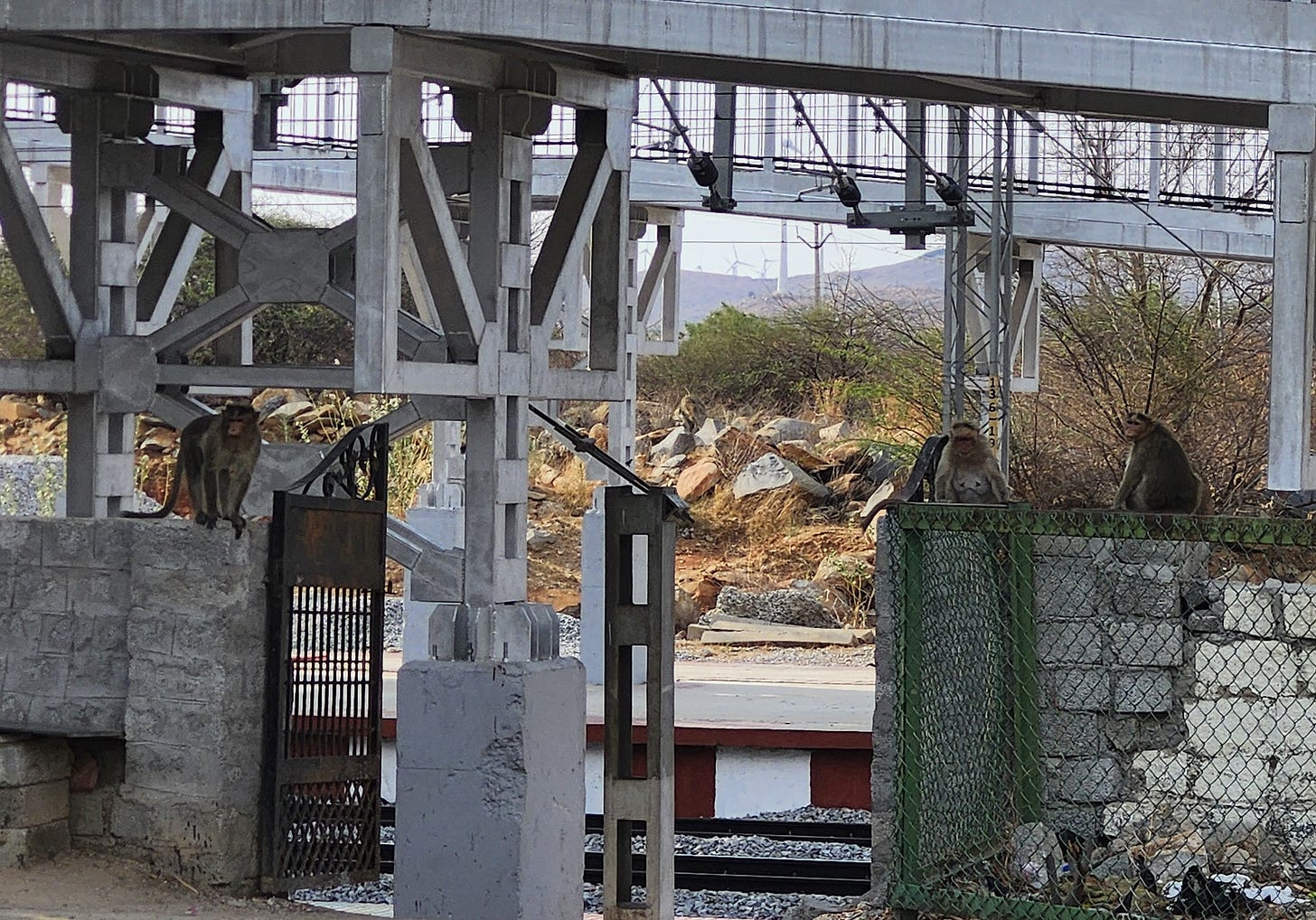
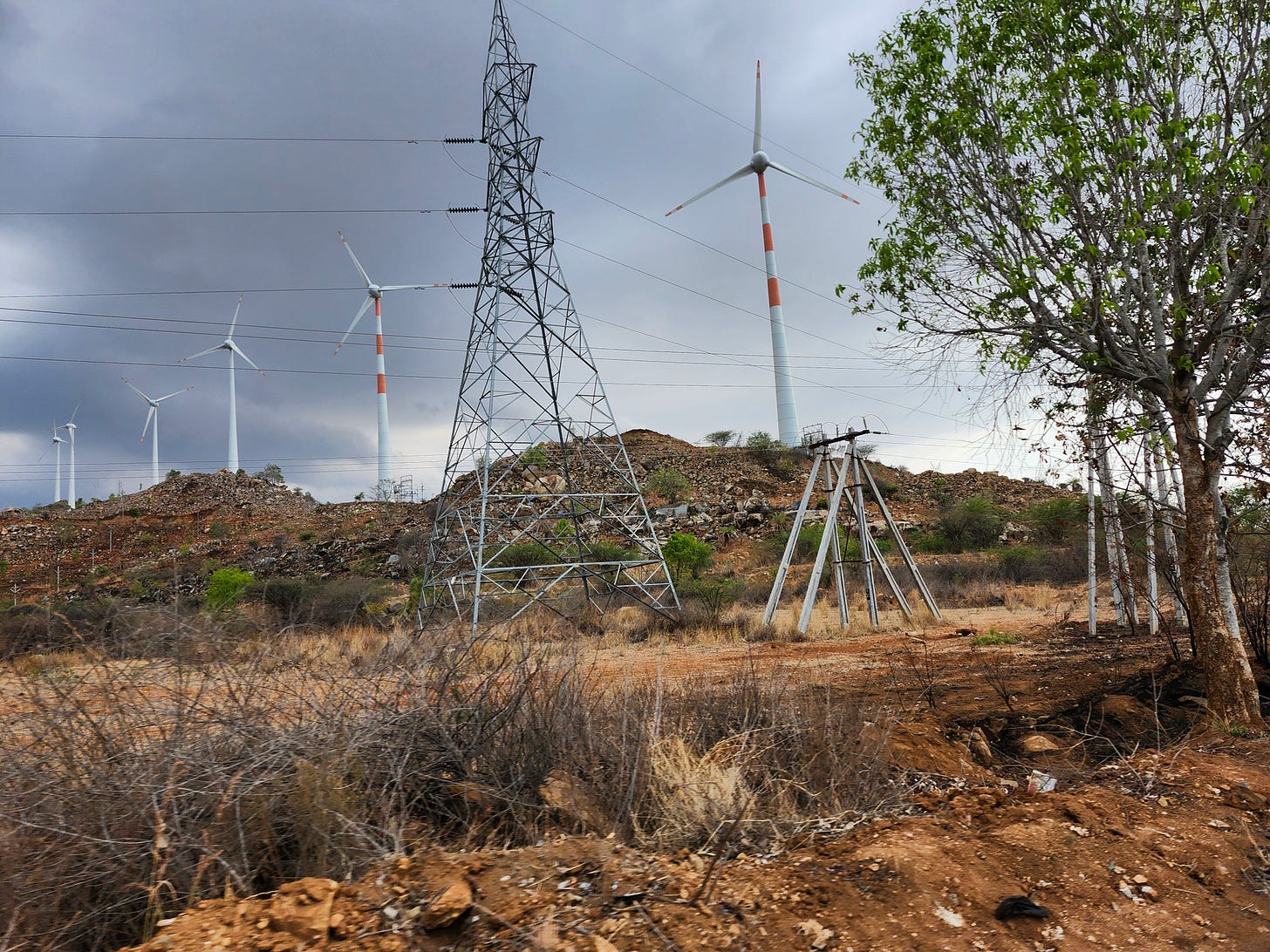

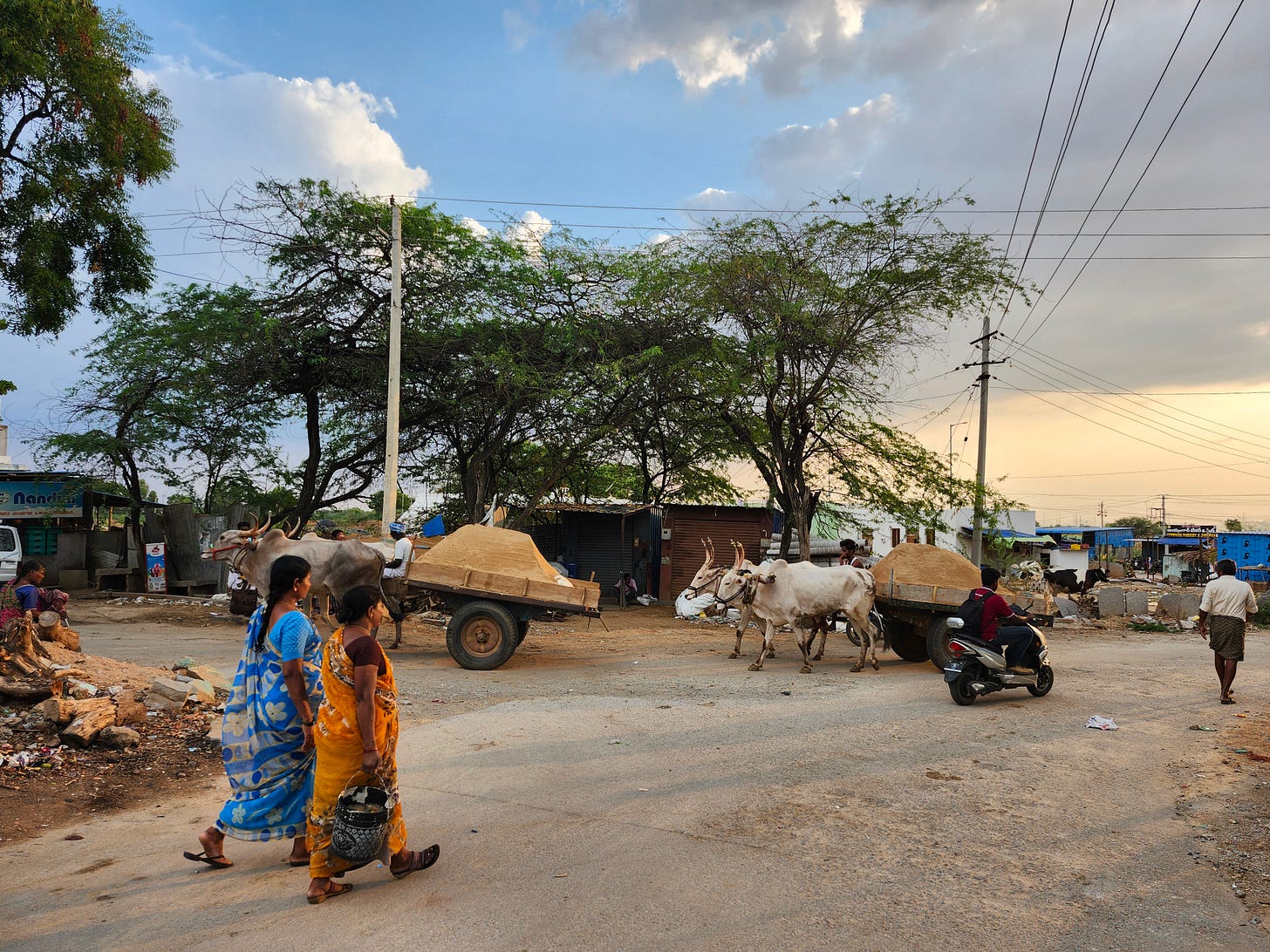
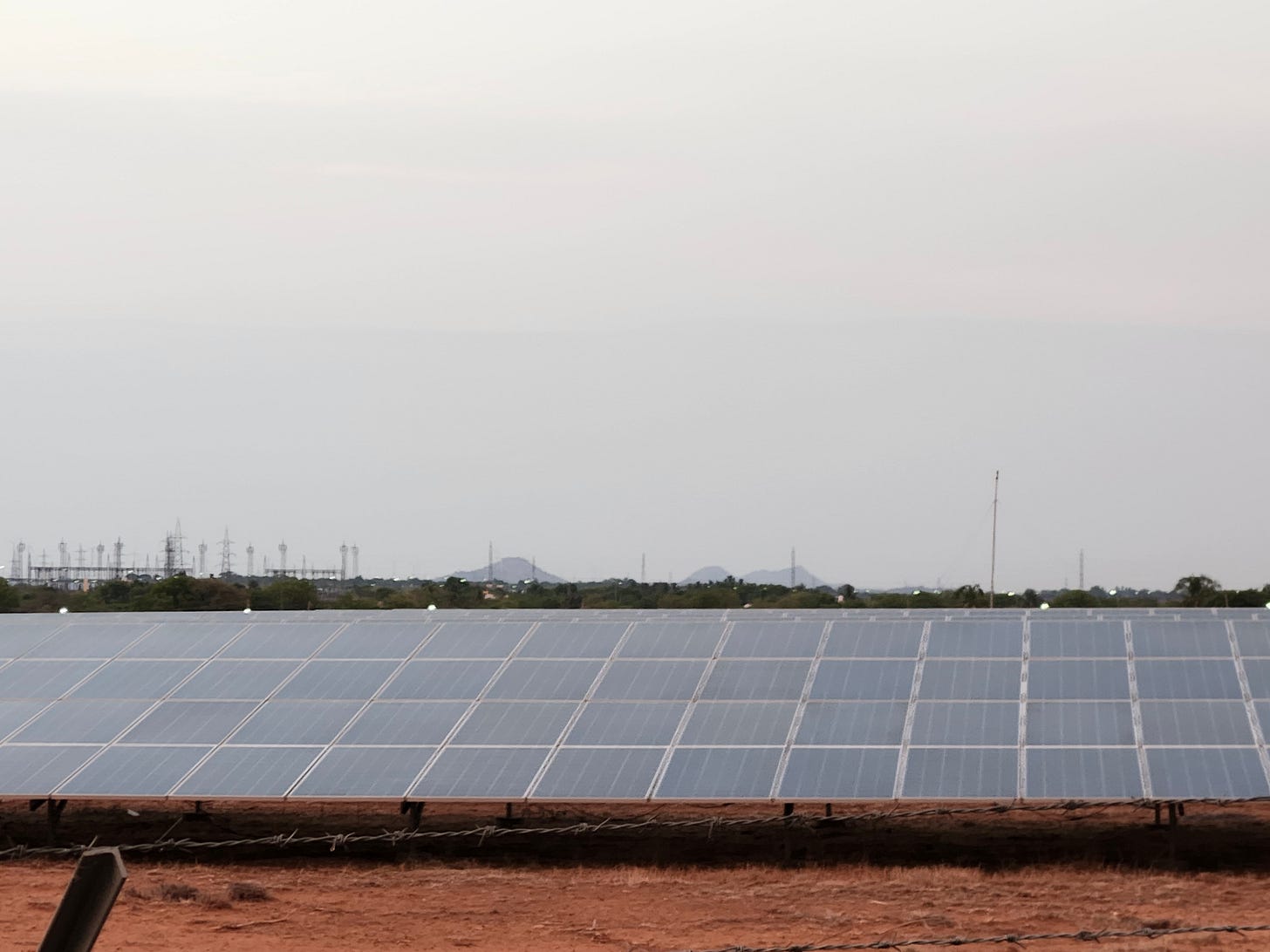


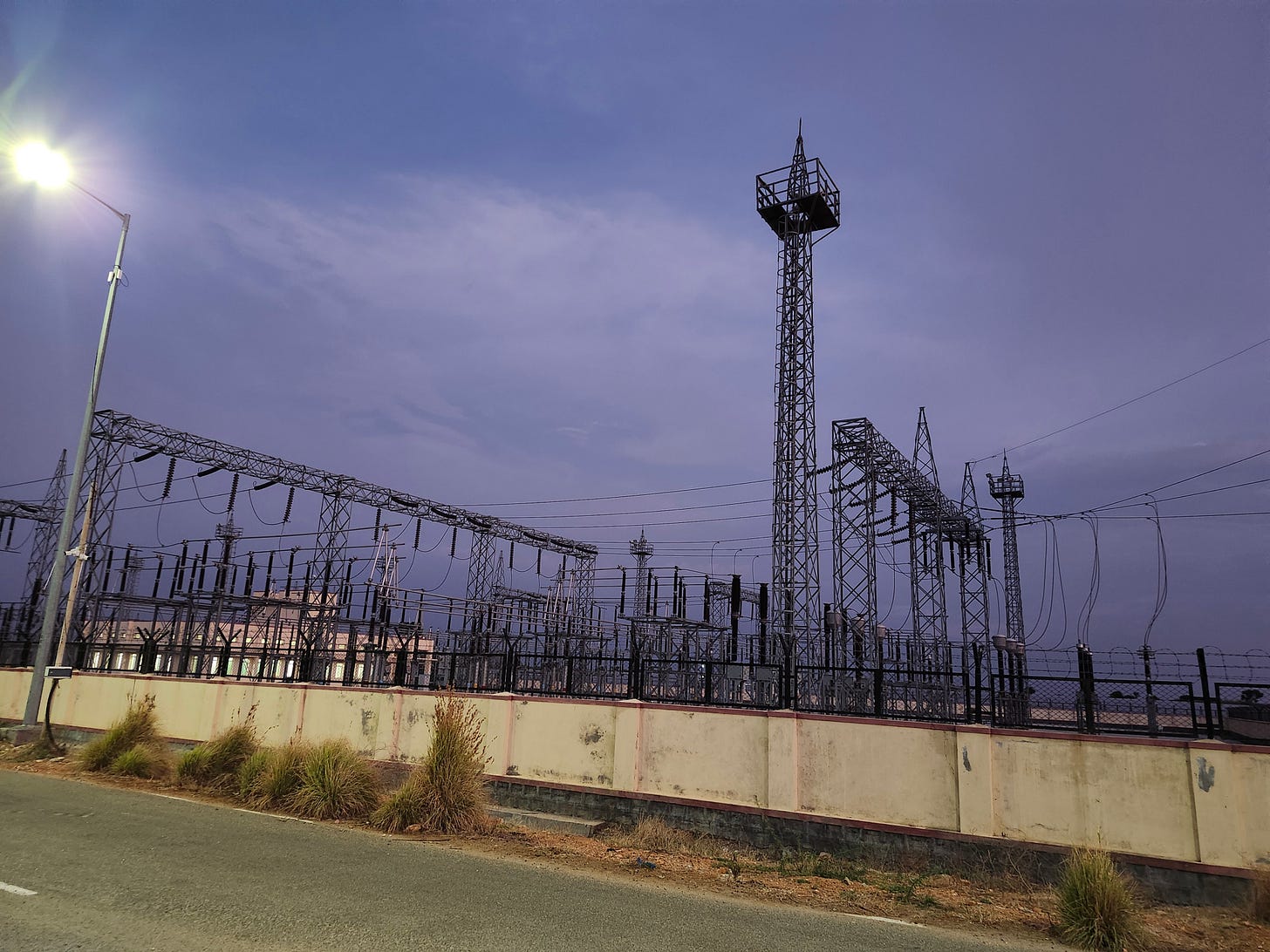

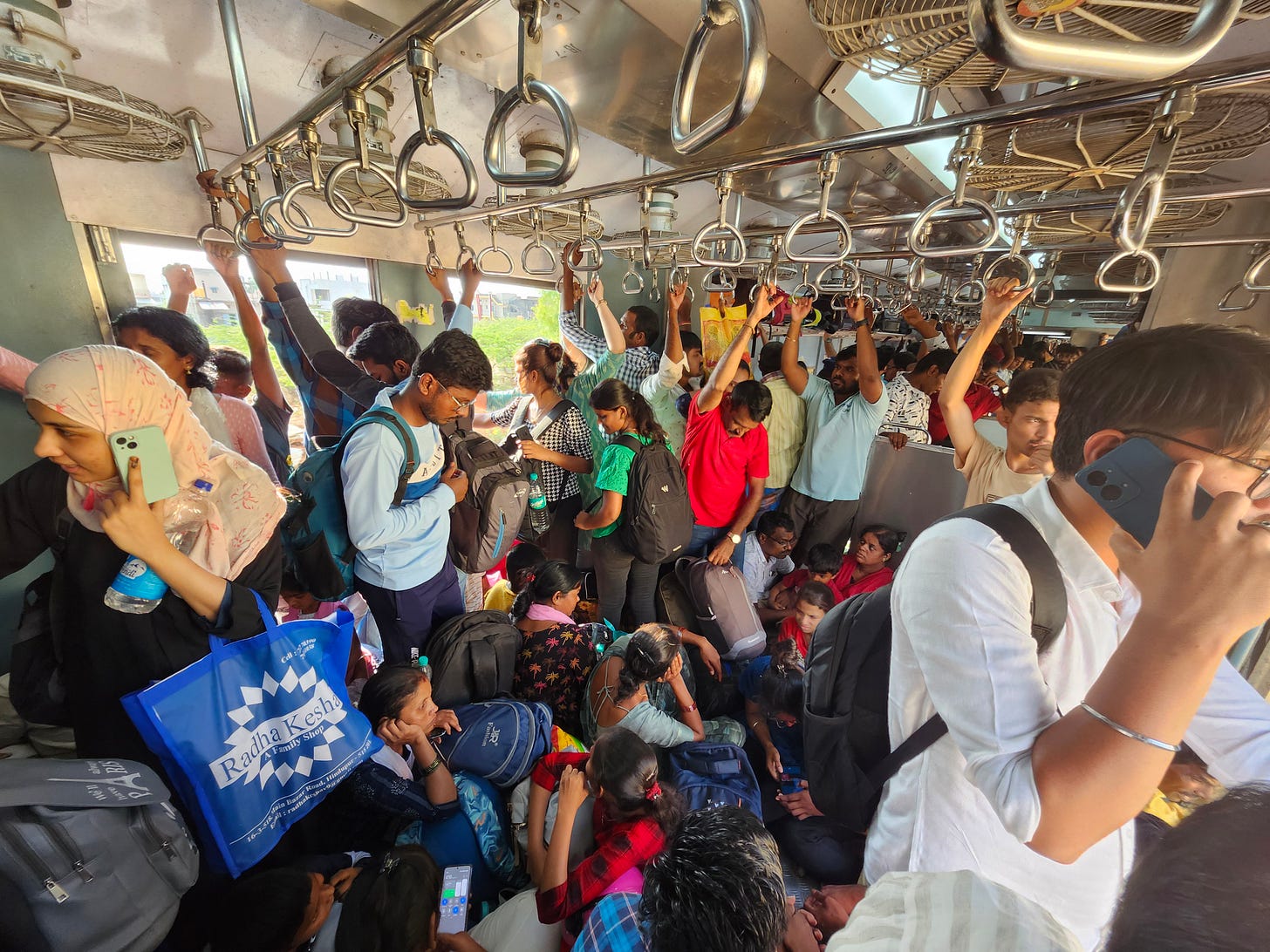
India continues to amaze..it seems a place one could move to, get citizenship and then "live happily ever after.". Great reporting!
"Culturally, it appeared to me as a fascinating melange of past, present, and future."
When I was in Mumbai in 2018, I saw a guy on a fruit wagon being pulled through traffic by a bull, while he was talking on a cell phone. Three generations of technological progress (my dad's horse-to-car transition, my home computer transition, and my kid's cell phone transition) in one moment.